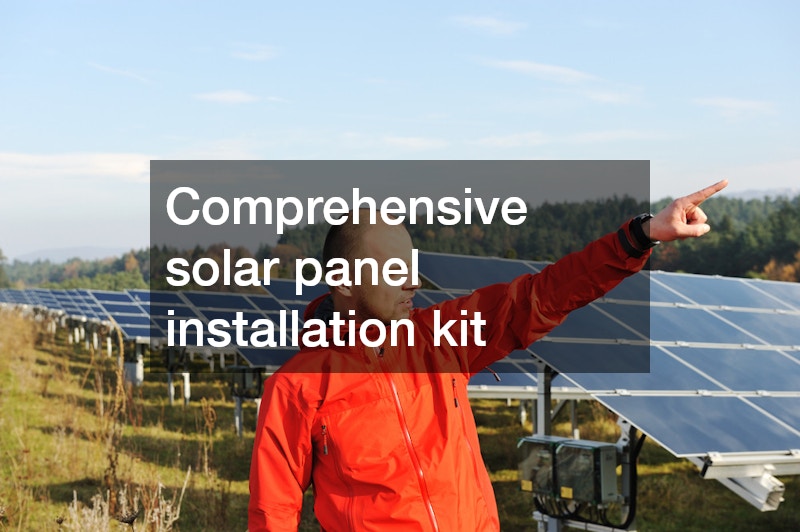
Many ecologically minded homeowners have embraced installing solar panels in their homes. Solar panels collect energy from the sun, which results in protecting the environment and reducing energy bills. You may wonder whether you can install your own solar panels with a solar power package or contact a solar installer. Many homeowners have found that, with a whole home solar kit, they are able to install the panels themselves.

If you have friends or family who have already installed solar panels, they may be able to help you. When shopping for a home solar panel kit, look for a kit that will result in a complete home solar system. Finding a complete kit means all the hardware and accessories needed for your panel installation will be there.

One example of a comprehensive solar panel installation kit would be a Solar and Battery Kit. Such kits would include the solar panels plus an inverter, which transforms the DC power from the solar panels into AC power used by household appliances. The kit also contains a charge controller (to regulate the energy coming from the panels) and batteries to store the power for days when the sun isn’t shining. The kit is complete with hardware, wiring, and connectors.

In the digital era, information about solar panels has become widespread. Technological advancements facilitate the access of information, including where to get affordable solar panels for home use. It is as easy as typing ‘affordable solar power systems near me’.
If you are embarking on building your home, it is vital to add solar panels to house costs. After a thorough search into the solar systems within your budget, select the most suitable depending on your energy requirements.
It is advisable to install solar panels as it will help you save on electricity bills. With solar panels, you also have a backup in case there is no electricity. Solar panels absorb solar energy to generate electricity or heat.
The solar system is made up of several cells that convert sunlight into electricity. Solar panels are environmentally friendly as they only depend on the sun as a raw material. With this, the panels do not emit any chemicals or smoke, hence being safe for your health.
When choosing a solar panel company, ensure that the company deals with quality brands. In addition, the company should have reliable and approved installation services. Make inquiries about the terms of getting a solar panel repair service to ensure you do not experience any breakdown without a solution.

Solar panels are a great addition to any home. First of all, they reduce energy bills by supplying the house with an alternative form of energy. Secondly, they help protect the environment by reducing the consumption of harmful resources of energy. Thirdly, they increase the value of your home when it comes to sell.
However, many people hem and haw over their installation, because they don’t know how to install solar panels. They think it costs an arm and a leg to hire an installation company, let alone buying them. Simply put, these naysayers are wrong. Learning how to install solar panels is easier than you’d think.
To help you learn how to install solar panels, here’s a quick guide explaining how to install solar panels for your own home!
1. Find the Right Spot.
Your first step is to find a spot where they’ll receive the maximum amount of coverage. People typically like to put them on their roofs, but there are tons of solar panel mounting systems to accommodate placement in other places, too. You can put them on the ground, on poles, and even on your RV roof if you so choose.
2. Figure Out the Latitude Tilt.
Your solar panels need to tilt towards the sun in the sun in the amount of your latitude number if you live below 25 degrees latitude. If you live directly at 25 degrees, your panels should be tilted by 25 degrees. After 25 degrees, you’ll have to add ten degrees for every five degrees of latitude up to forty degrees. For example, 30 latitude equals 40 degree tilt; 35 latitude equals 50 degree tilt. At 40 degrees latitude, you’ll want to add 20 degrees of tilt to your latitude number. So if your latitude was 50, you should tit your panels by 70 degrees.
3. Placing the Mounts.
You should place your mounts by about four feet apart. If you plan on going the conventional route of placing the panels on top of your roof, you can use a stud finder, or the blueprints of your home to find what rafters they should go on.
4. Secure the Mounts.
The next step on how to install solar panels is to secure everything with steel bolts. You should make sure that the area around the steel bolts is sealed to keep the thermal envelope air tight.
5. Fasten the Panels.

At last, we come to the step on our “how to install solar panels” list when we actually get to install the panels. The panels usually have an easy-to-fasten panel to mount interface, but make sure that they’re off the roof by about three inches, because the airflow beneath them will keep them running at maximum efficiency.
6. Connect.
The last, and best, step on our “how to install solar panels” guide is to hook it all up! It’s best to consult your local electrician how to connect your panels to your electric supply, but, at this phase, you’re ready to do so!
There you have it folks. That’s basically how to install solar panels. If you have any questions, feel free to ask in the comments. More like this article.